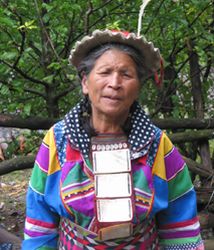Baima Profile
Autonym: pe53
Other names: 白马
The 14,000 Baima inhabit a beautiful region in northern Sichuan and the edge of Gansu Province. They share their homeland with Giant Pandas. Though officially classified as Tibetan, the Baima are proud of their unique culture and heritage. Their appearance is immediately striking. Those who are married wear hats made from felt adorned with white cockerel feathers, and the women wear fishbone necklaces over their colorful tunics. The Baima have never embraced Tibetan Buddhism, but instead follow their indigenous animist religion. The Baimalanguage has been a point of debate among linguists. In certain respects it has a few similarities with the Qiangic languages, but following recent research by Sun Hongkai(1) opinion seems to be veering towards a consensus that Baima is much more akin to Tibetan, and yet it is still distinctly different from Amdo or Kham. With such conspicuous ethnic features, it’s hardly surprising that in the 1960s and 70s the Baima campaigned (unsuccessfully) for reclassification as a separate nationality from the Tibetans, claiming to be descendants of the ancient Di tribe(2), a group probably related to the Qiang. This controversy subsequently died down however and the Baima generally accept their Tibetan status today.
Though once remote from and untouched by outsiders, the very beauty of the Baima area could yet spell the undoing of their centuries-old lifestyle. With the Jiuzhaigou World Heritage Site just up the road, the Baima villages now find themselves on a prime tourist route. On one hand it will serve to preserve remnants of the Baima culture, and yet the effect on that culture of multitudes of tourists invading it each year is immeasurable.


